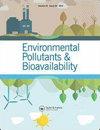减少和控制空气污染:基于植物与微生物的相互作用
IF 3.2
4区 环境科学与生态学
Q2 BIOCHEMISTRY & MOLECULAR BIOLOGY
Environmental Pollutants and Bioavailability
Pub Date : 2023-02-17
DOI:10.1080/26395940.2023.2173657
引用次数: 1
摘要
本文章由计算机程序翻译,如有差异,请以英文原文为准。
Reduction and control of air pollution: based on plant-microbe interactions
ABSTRACT Economic development brings environmental challenges of which air pollution poses serious risks to humans and ecosystems. Air pollutants include volatile organic compounds (VOCs), inorganic air pollutants (IAPs) and particulate matter (PMs). Plant leaves may reduce such air pollution through adsorption and stomatal absorption. At the same time, air pollutants enter soil and root zones due to its content in rain and leaf fall. Microorganisms degrade and transform air pollutions. However, the efficiency of phytoremediation and bioremediation is slow and the use of plant-microbe interactions may therefore greatly enhance the efficiency of phytoremediation. The release of chemicals from plants leads to a mutual interaction with the microbiome that promotes the growth of the plant itself, thus enhancing degradation and detoxification of interleaf and inter-root air pollutants. Here we review the current research progress on combined plant-microbe action and discusses the interaction between plants and associated microorganisms while providing perspectives for future research in phytotechnologies. Graphical Abstract
求助全文
通过发布文献求助,成功后即可免费获取论文全文。
去求助
来源期刊

Environmental Pollutants and Bioavailability
Chemical Engineering-Chemical Health and Safety
CiteScore
4.30
自引率
3.00%
发文量
47
审稿时长
13 weeks
期刊介绍:
Environmental Pollutants & Bioavailability is a peer-reviewed open access forum for insights on the chemical aspects of pollutants in the environment and biota, and their impacts on the uptake of the substances by living organisms.
Topics include the occurrence, distribution, transport, transformation, transfer, fate, and effects of environmental pollutants, as well as their impact on living organisms. Substances of interests include heavy metals, persistent organic pollutants, and emerging contaminants, such as engineered nanomaterials, as well as pharmaceuticals and personal-care products as pollutants.
 求助内容:
求助内容: 应助结果提醒方式:
应助结果提醒方式:


